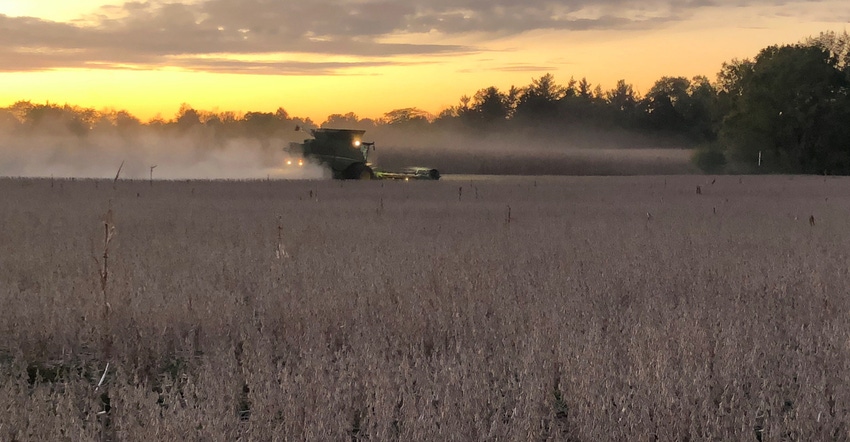
How important is measuring soybean harvest loss in the field? Chuck Burr, an Extension specialist with the University of Nebraska, says it’s simply a matter of math and economics.
“As little as four to five soybeans per square foot left behind on the ground add up to 1 bushel per acre of loss,” Burr says. “The rule of thumb is typically four beans per square foot if beans are average size, and five beans per square foot if they’re small.
“With soybean prices where they are today, it is well worth an operator’s time to check for harvest losses.”
Yield loss due to soybeans left behind begins even before the combine arrives. Some pods may split open and allow beans to shatter before harvest. Check for this before you begin combining. Then when you stop to measure soybean losses, you know whether beans on the ground are from preharvest loss or harvesting.
“One major cause of harvest loss stems from harvesting soybeans when they’re too dry,” Burr says. “Dry soybeans lead to shatter, and beans end up on the ground.”
Why moisture level matters
You don’t need a degree in astrophysics to understand that harvesting soybeans too dry leads to more shattering. Extra shattering means more beans on the ground that should have wound up in the grain tank. That means bushels and dollars left in the field.
“The drier the soybeans, the easier it is for them to shatter,” Burr says. “The more soybeans that shatter, the more you leave behind. It’s really that simple.”
So where should you start if you want to minimize soybean harvest losses?
“Try to harvest soybeans when moisture in the sample is at 14% to 15%,” Burr says. “If stems are still green, make combine adjustments and operate at slower speeds.
“If beans are already too dry, wait to harvest late in the day and early in the morning.”
Moisture tends to pick up in the evening, especially as fall approaches. With modern machines, it’s easier to harvest into the evening, as long as you can still get crop material through the machine.
“If you have grain bin space available, start harvesting soybeans at 16% to 18% moisture; put them in the bin and aerate them until they reach 13%,” Burr says. “For a field harvested at 9% moisture at 75 bushels per acre, you are giving up 3.3 bushels due to moisture below 13% alone. Additional losses occur once soybeans which are that dry shatter during harvest and end up on the ground.”

University of Georgia Extension published relevant information on measuring and reducing harvest losses beginning in 2006. Here are highlights, including extra information from Michigan State University and South Dakota State University. First, understand these terms:
Total crop loss. This includes preharvest loss plus all machine loss.
Machine loss. This group breaks down into gathering loss, cylinder loss and separation loss.
Gathering loss. This encompasses shattering, stubble loss, lodging and stalk loss. Stubble loss consists of beans left in pods on the stubble. Lodged loss includes stalks that fell over during harvest and weren’t cut free. Stalk loss refers to stalks that were cut but did not make it into the machine. With 80 to 120 beans per stalk, finding one stalk in a 10-square-foot sampling area causes losses to skyrocket.
Example
Consider this example: Suppose you construct a 10-square-foot frame. You lay it down in four areas behind the combine. You find 100, 90, 110 and 110 beans per sampling area. You checked in standing beans and found 20, 10, 20 and 20 beans before harvest. You don’t find any lodged or loose stalks.
Harvest losses are 80, 80, 90 and 90 beans per 10 square feet — or 8, 8, 9 and 9 beans per square foot, for an average of 8.5 beans per square foot. Dividing by four beans per square foot, that’s 2.1 bushels per acre. For 60-bushel beans, it’s just over 3% loss.
According to Michigan State University, 3% harvest loss is a reasonable goal. Determine your loss percentage. If it’s high, adjust one combine setting at a time and remeasure. Continue until you reduce harvest losses to a reasonable level.
About the Author(s)
You May Also Like




